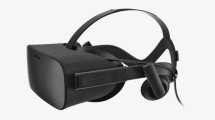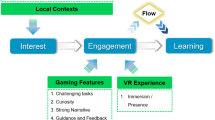Abstract
A primary affordance of virtual reality (VR) headsets is to give the user spatial presence or the illusion of being in the virtual environment. Although considerable research connects VR to spatial presence, spatial awareness, and spatial ability, little is known about how users develop spatial presence in VR learning environments. This study addresses that gap by exploring spatial presence experience construction in a VR educational game and investigating whether users’ knowledge, game experience, and VR experience impact the establishment of spatial presence. In this study, 56 high school students played an immersive 3D VR cell biology game where players search for clues within a virtual cell to diagnose the cell. Findings suggest that players’ perceptions of spatial presence are linked to how they allocate their attention during the game, their level of interest in cellular biology, and their visual-spatial acuity, but are not linked to their game experience, VR experience, or prior knowledge of the content area. These results indicate that well-scaffolded, engaging virtual environments can foster spatial presence among users, regardless of prior knowledge or experience, and gives practitioners clues about how to design VR learning environments.



Similar content being viewed by others
References
Cheng K-H, Tsai C-C (2019) A case study of immersive virtual field trips in an elementary classroom: students’ learning experience and teacher-student interaction behaviors. Computers & Education, 140. https://doi.org/10.1016/j.compedu.2019.103600
Coxon M, Kelly N, Page S (2016) Individual differences in virtual reality: are spatial presence and spatial ability linked? Virtual Reality 20(4):203–212. https://doi.org/10.1007/s10055-016-0292-x
Cummings JJ, Bailenson JN (2016) How immersive is enough? A meta-analysis of the effect of immersive technology on user presence. Media Psychol 19(2):272–309. https://doi.org/10.1080/15213269.2015.1015740
Flores F, Tovar ME, Gallegos L (2003) Representation of the cell and its processes in high school students: an integrated view. Int J Sci Educ 25(2):269–286
Gillath O, Mccall C, Shaver PR, Blascovich J (2008) What can virtual reality teach us about prosocial tendencies in real and virtual environments? Media Psychol 11(2):259–282. https://doi.org/10.1080/15213260801906489
Hartmann T, Wirth W, Vorderer P, Klimmt C, Schramm H, Böcking S (2015) Spatial presence theory: state of the art and challenges ahead. In: Immersed in media. Springer, Cham, pp 115–135
Hartmann T, Wirth W, Schramm H, Klimmt C, Vorderer P, Gysbers A, Böcking S, Ravaja N, Laarni J, Saari T, Gouveia F, Sacau AM (2016) The spatial presence experience scale (SPES): A short self-report measure for diverse media settings. J Media Psychol 28(1):1–15. https://doi.org/10.1027/1864-1105/a000137
Hedge C, Weaver R, Schnall S (2017) Spatial learning and wayfinding in an immersive environment: the digital fulldome. Cyberpsychol Behav Soc Netw 20(5):327–333
Hofer M, Wirth W, Kuehne R, Schramm H, Sacau A (2012) Structural equation modeling of spatial presence: the influence of cognitive processes and traits. Media Psychol 15(4):373–395. https://doi.org/10.1080/15213269.2012.723118
da Silva Hounsell, M., Kemczinski, A., & Schlindwein, L. F. M. (2013). A comparative study on aspects that influence the sense of presence in virtual environments. Revista Brasileira de Computação Aplicada 5(1): 113-125.
Khenak N, Vezien JM, Thery D, Bourdot P (2019) Spatial presence in real and remote immersive environments. In: 2019 IEEE conference on virtual reality and 3D user interfaces (VR). IEEE, pp 1016–1017
Lachlan K, Krcmar M (2011) Experiencing presence in video games: the role of presence tendencies, game experience, gender, and time spent in play. Commun Res Rep 28(1):27–31. https://doi.org/10.1080/08824096.2010.518924
Larkin DLS (2015) The effects of stereoscopic 3D technology: limited capacity, and a process-oriented model of spatial presence. Doctoral dissertation, University of Alabama Libraries
Lessiter J, Freeman J, Keogh E, Davidoff J (2001) A cross-media presence questionnaire: The ITC-sense of presence inventory. Presence Teleoper Virtual Environ 10(3):282–297. https://doi.org/10.1162/105474601300343612
Ling Y, Nefs HT, Brinkman WP, Qu C, Heynderickx I (2013) The relationship between individual characteristics and experienced presence. Comput Hum Behav 29(4):1519–1530. https://doi.org/10.1016/j.chb.2012.12.010
Lombard M, Ditton TB, Weinstein L (2009) Measuring presence: the temple presence inventory. In: Proceeding of presence 2009 : the 12th international workshop on presence, January, 1–14. http://www.temple.edu/ispr/prev_conferences/proceedings/2009/Lombard_et_al.pdf
Mayer RE, Moreno R (2003) Nine ways to reduce cognitive load in multimedia learning. Educ Psychol 38(1):43–52
Pallant J (2007) Survival manual. A step by step guide to data analysis using SPSS. Mc Graw Hill, Open University Press, New York
Parong J, Pollard KA, Files BT, Oiknine AH, Sinatra AM, Moss JD, Passaro A, Khooshabeh P (2020) The mediating role of presence differs across types of spatial learning in immersive technologies. Computers in Human Behaviour 107. https://doi.org/10.1016/j.chb.2020.106290
Sacau A, Laarni J, Ravaja N, Hartmann T (2005) The impact of personality factors on the experience of spatial presence. Drama, pp 143–151
Seibert J, Shafer DM (2018) Control mapping in virtual reality: effects on spatial presence and controller naturalness. Virtual Reality 22(1):79—88. https://doi.org/10.1007/s10055-017-0316-1
Stevens J (1996) Applied multivariate statistics for the social sciences (3rd edn). Mahwah, NJ:Lawrence Erlbaum
Uz Bilgin, C., Anteneh, M. R., & Thompson, M. (2021). What's So Special About Spatial?: A Review Study Joining Virtual Reality and Spatial Ability. In Russell, D. (Ed.), Implementing Augmented Reality Into Immersive Virtual Learning Environments (pp. 56-73). IGI Global. http://doi:10.4018/978-1-7998-4222-4.ch003
Vorderer P, Wirth W, Gouveia FR, Biocca F, Saari T, Jäncke L, Böcking S, Schramm H, Gysbers A, Hartmann T, Klimmt C (2004) MEC spatial presence questionnaire. Retrieved January, 18, 2020.
Wang A (2020) Creators, classrooms, and cells: designing for the benefits and limitations of learning in immersive virtual reality. Master Thesis, Massachusetts Institute of Technology, Cambridge, USA
Weibel D, Wissmath B (2011) Immersion in computer games: the role of spatial presence and flow. Int J Comput Games Technol. https://doi.org/10.1155/2011/282345
Wirth W, Vorderer P, Hartmann T, Klimmt C, Schramm H (2003) Constructing presence : towards a two-level model of the formation of spatial presence experiences. Communication 2003(8):37661–37661
Wirth W, Hartmann T, Böcking S, Vorderer P, Klimmt C, Schramm H, Saari T, Laarni J, Ravaja N, Gouveia FR, Biocca F, Sacau A, Jäncke L, Baumgartner T, Jäncke P (2007) A process model of the formation of spatial presence experiences. Media Psychol 9(3):493–525. https://doi.org/10.1080/15213260701283079
Witmer BG, Singer MJ (1998) Measuring presence in virtual environments: a presence questionnaire. Presence 7(3):225–240
Yildirim Ç, Bostan B, Berkman Mİ (2019) Impact of different immersive techniques on the perceived sense of presence measured via subjective scales. Entertain Comput 31:5. https://doi.org/10.1016/j.entcom.2019.100308
Funding
This material is based upon work supported by Oculus Education.
Author information
Authors and Affiliations
Corresponding author
Ethics declarations
Conflict of interest
The authors declare that they have no conflict of interest.
Ethics approval
All procedures performed in studies involving human participants were in accordance with the ethical standards of the institutional and national research committee. Research on human subjects has been approved by the Institutional Review Board of Massachusetts Institute of Technology.
Consent to participate
Informed consent was obtained from all individual participants included in the study.
Consent for publication
All authors consent to the publication of the manuscript in Virtual Reality Journal.
Additional information
Publisher's Note
Springer Nature remains neutral with regard to jurisdictional claims in published maps and institutional affiliations.
Rights and permissions
About this article
Cite this article
Uz-Bilgin, C., Thompson, M. Processing presence: how users develop spatial presence through an immersive virtual reality game. Virtual Reality 26, 649–658 (2022). https://doi.org/10.1007/s10055-021-00528-z
Received:
Accepted:
Published:
Issue Date:
DOI: https://doi.org/10.1007/s10055-021-00528-z




